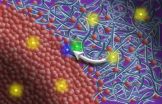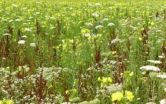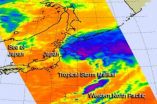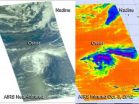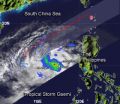(Press-News.org) RICHMOND, Va. (Oct. 4, 2012) – A new study reveals that a significant amount of carbon released into the atmosphere from lakes and rivers in Southern Québec, Canada, is very old – approximately 1,000 to 3,000 years old – challenging the current models of long-term carbon storage in lakes and rivers.
Previous studies have suggested that there is a tight coupling between the terrestrial and aquatic environment such that aquatic bacteria rapidly consume modern carbon. The new findings of the respiration of old carbon in aquatic systems suggests there may be significant lags in the coupling between these systems and further represents an additional, unaccounted for source of carbon dioxide to the atmosphere.
It is well established that bacteria in northern waters process carbon from their terrestrial surroundings. But the findings from Virginia Commonwealth University in Richmond, Va., and Université du Québec à Montréal in Montreal, Canada, challenge the widely held belief that older carbon sources are not available to bacteria and have been largely removed from the carbon feedback loop between earth and air.
In a new study published online this week in the Early Edition of the Proceedings of the National Academy of Sciences, S. Leigh McCallister, assistant professor of biology in the VCU College of Humanities and Sciences and the VCU Center for Environmental Studies and an affiliate faculty member in the VCU Rice Center, and Paul A. del Giorgio, Ph.D., professor in the Department of Biological Sciences at the Université du Québec à Montréal, used radiocarbon dating to assess the age of carbon respired by bacteria and released into the atmosphere as carbon dioxide. They observed that some of the carbon consumed dated as far back as 1,000 to 3,000 years.
While these findings are regional, McCallister and del Giorgio noted that if most northern waterways are likewise selectively processing older carbon, the global output of carbon dioxide from these ancient sources could be significant. Carbon dioxide is a greenhouse gas and its increase in the atmosphere provides a positive feedback to climate change, meaning it amplifies it.
"While it is not clear if this release of ancient carbon is new or related to anthropogenic climate change, it supplies an additional source of carbon dioxide to the atmosphere," said McCallister.
"This study illustrates the need to incorporate the potential processing of pre-aged, or older, carbon sources into current carbon models," she said.
INFORMATION:
This study was supported by grants from the National Science Foundation DEB 0820725, the National Science and Engineering Research Council of Canada, Hydro-Québec, and the Fonds Quebecois de la recherche sur la nature et les technologies.
EDITOR'S NOTE: A copy of the study is available for reporters by contacting the PNAS News Office at 202-334-1310 or PNASnews@nas.edu.
Researchers find ancient carbon resurfacing in lakes
Findings challenge current models of long-term carbon storage in lakes and rivers
2012-10-05
ELSE PRESS RELEASES FROM THIS DATE:
Northern conifers youngest of the species
2012-10-05
New Haven, Conn.—Dramatic shifts in the planet's climate and geography over millions of years changed the course of evolutionary history for conifer trees, according to a Yale paper in the Proceedings of the National Academy of Sciences.
Yale researchers examined the fossil record and genetic makeup of 489 out of more than 600 living conifer species and discovered that while most conifers belong to ancient lineages, most Northern Hemisphere species, including the majority of pines and spruces, appeared within the past 5 million years.
They argue that the migration ...
Researchers reveal how solvent mixtures affect organic solar cell structure
2012-10-05
Controlling "mixing" between acceptor and donor layers, or domains, in polymer-based solar cells could increase their efficiency, according to a team of researchers that included physicists from North Carolina State University. Their findings shed light on the inner workings of these solar cells, and could lead to further improvements in efficiency.
Polymer-based solar cells consist of two domains, known as the acceptor and the donor layers. Excitons, the energy particles created by solar cells, must be able to travel quickly to the interface of the donor and acceptor ...
Improving confidence keeps breast cancer survivors exercising
2012-10-05
CORVALLIS, Ore. – More than 40 percent of older breast cancer survivors are insufficiently active after leaving a supervised program. But new research shows that those women who developed behavioral skills such as self-confidence and motivation during their program were far more likely to continue exercising on their own.
Regular exercise may reduce the risk of breast cancer recurrence and breast cancer-related mortality, experts say, making it crucial to effectively target breast cancer survivors who do not engage in regular physical activity for interventions.
Researchers ...
Why we need insects -- even 'pesky' ones
2012-10-05
At first blush, many people would probably love to get rid of insects, such as pesky mosquitoes, ants and roaches. But a new study indicates that getting rid of insects could trigger some unwelcome ecological consequences, such as the rapid loss of desired traits in plants, including their good taste and high yields.
Specifically, the study--described in the Oct. 5, 2012 issue of Science and funded by the National Science Foundation showed that evening primroses grown in insecticide-treated plots quickly lost, through evolution, defensive traits that helped protect them ...
MU researcher identifies factors to help parents and professionals recognize teens in distress
2012-10-05
Suicide is the third-leading cause of death for teens, according to the Centers for Disease Control and Prevention. Now, a University of Missouri public health expert has identified factors that will help parents, medical professionals and educators recognize teens at risk for self injury and suicide.
"For many young people, suicide represents an escape from unbearable situations—problems that seem impossible to solve or negative emotions that feel overwhelming," said Lindsay Taliaferro, an assistant professor of health sciences at MU. "Adults can help these teens dissect ...
Sandia Labs benchmark helps wind industry measure success
2012-10-05
ALBUQUERQUE, N.M. – Sandia National Laboratories published the second annual 2012 Wind Plant Reliability Benchmark on Monday, and the results should help the nation's growing wind industry benchmark its performance, understand vulnerabilities and enhance productivity.
Until now, wind farm owners and operators had no way to compare their output with the output of similar operations. To benchmark the reliability of the U.S. wind turbine fleet and identify major causes of failures and downtime, the DOE commissioned Sandia in 2010 to build the Continuous Reliability Enhancement ...
Far, far beyond wrist radios
2012-10-05
To believe that technologies once dreamed of in science fiction novels, television shows, and comic strips may one day be a reality, or that real-world technologies might make the fantastic devices of fiction obsolete, you'd need to be either an optimist…or a futurist in the Department of Homeland Security (DHS)'s Science and Technology Directorate (S&T).
To keep dreams grounded, S&T maintains a team of futurists in Arlington, Va., at the Homeland Security Studies & Analysis Institute (HSSAI). There, in the Resilience and Emergency Preparedness / Response Branch, analysts ...
NASA sees Tropical Storm Maliksi put final touches on Japan
2012-10-05
Tropical Storm Maliksi is putting the final touches on Japan, that is, the edge of the storm was seen brushing the country's northern coast as it pulled away on NASA satellite imagery.
NASA's Aqua satellite passed over Tropical Storm Maliksi on Oct. 4 at 0329 UTC (11:29 p.m. EDT, Oct. 3, EDT) and the Atmospheric Infrared Sounder (AIRS) instrument captured an infrared image of the storm brushing the Tohoku and Hokkaido prefectures of northern Japan.
On Oct. 4, 2012 at 1500 UTC (11 a.m. EDT), the Joint Typhoon Warning Center issued their final advisory on Maliksi. At ...
NASA gets 2 infrared views of tropical storms Nadine, Oscar
2012-10-05
NASA's Aqua satellite provided two different infrared views of the two tropical storms swirling in the Atlantic Ocean. Oscar is battling wind shear that appears destined to tear it apart, while Nadine is merging with a cold front.
NASA's Aqua satellite passed over both Tropical Storm Nadine and Tropical Depression 15 (TD15) on Oct. 3 at 1553 UTC (11:53 a.m. EDT), before TD15 became Tropical Storm Oscar. While overhead, the Atmospheric Infrared Sounder (AIRS) instrument aboard Aqua captured two different images of both storms. One image was near infrared and almost visible ...
NASA sees Tropical Storm Gaemi's heaviest rainfall around center
2012-10-05
Some of the most powerful thunderstorms in a tropical cyclone surround the center of circulation, and NASA's TRMM satellite noticed that rainfall is heaviest in that area of Tropical Storm Gaemi.
When NASA's Tropical Rainfall Measuring Mission (TRMM) satellite passed over Tropical Storm Gaemi on Oct. 3 at 1241 UTC (8:41 a.m. EDT), the precipitation radar instrument detected light rainfall occurring over most of the storm. Moderate rain was falling at a rate between .78 to 1.57 inches/20 to 40 mm per hour and surrounded a small area of heavy rainfall circling tightly around ...
LAST 30 PRESS RELEASES:
Making lighter work of calculating fluid and heat flow
Normalizing blood sugar can halve heart attack risk
Lowering blood sugar cuts heart attack risk in people with prediabetes
Study links genetic variants to risk of blinding eye disease in premature infants
Non-opioid ‘pain sponge’ therapy halts cartilage degeneration and relieves chronic pain
AI can pick up cultural values by mimicking how kids learn
China’s ecological redlines offer fast track to 30 x 30 global conservation goal
Invisible indoor threats: emerging household contaminants and their growing risks to human health
Adding antibody treatment to chemo boosts outcomes for children with rare cancer
Germline pathogenic variants among women without a history of breast cancer
Tanning beds triple melanoma risk, potentially causing broad DNA damage
Unique bond identified as key to viral infection speed
Indoor tanning makes youthful skin much older on a genetic level
Mouse model sheds new light on the causes and potential solutions to human GI problems linked to muscular dystrophy
The Journal of Nuclear Medicine ahead-of-print tip sheet: December 12, 2025
Smarter tools for peering into the microscopic world
Applications open for funding to conduct research in the Kinsey Institute archives
Global measure underestimates the severity of food insecurity
Child survivors of critical illness are missing out on timely follow up care
Risk-based vs annual breast cancer screening / the WISDOM randomized clinical trial
University of Toronto launches Electric Vehicle Innovation Ontario to accelerate advanced EV technologies and build Canada’s innovation advantage
Early relapse predicts poor outcomes in aggressive blood cancer
American College of Lifestyle Medicine applauds two CMS models aligned with lifestyle medicine practice and reimbursement
Clinical trial finds cannabis use not a barrier to quitting nicotine vaping
Supplemental nutrition assistance program policies and food insecurity
Switching immune cells to “night mode” could limit damage after a heart attack, study suggests
URI-based Global RIghts Project report spotlights continued troubling trends in worldwide inhumane treatment
Neutrophils are less aggressive at night, explaining why nighttime heart attacks cause less damage than daytime events
Menopausal hormone therapy may not pose breast cancer risk for women with BRCA mutations
Mobile health tool may improve quality of life for adolescent and young adult breast cancer survivors
[Press-News.org] Researchers find ancient carbon resurfacing in lakesFindings challenge current models of long-term carbon storage in lakes and rivers

